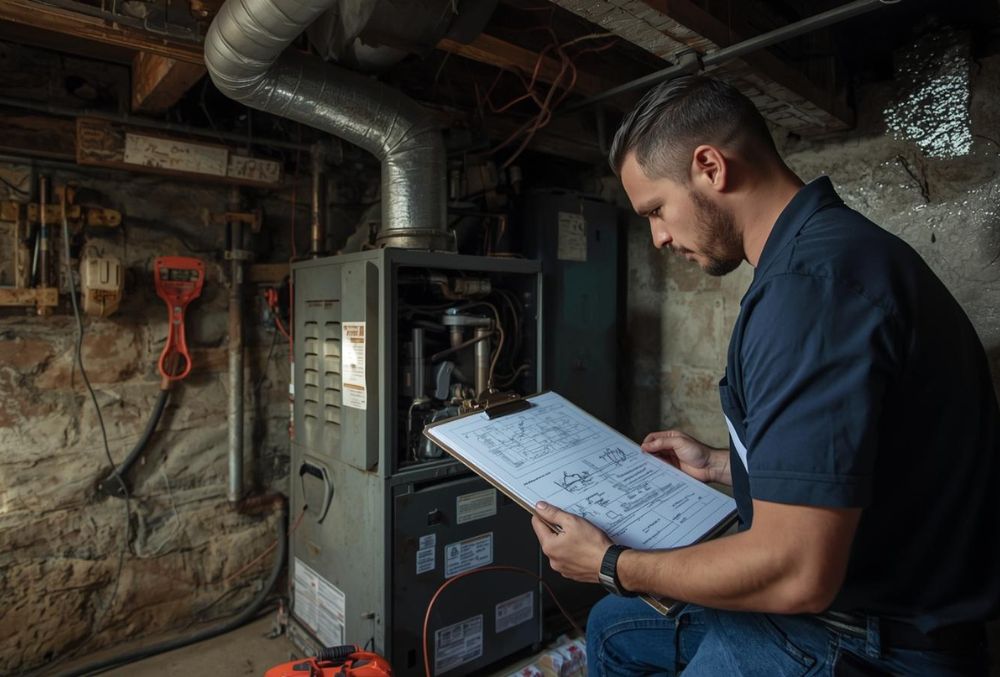Upgrading the furnace in an older home can feel like a major project, especially if you’re balancing comfort needs with efficiency goals. With the right preparation and expert guidance, the process becomes more manageable and far more rewarding. Whether your current system struggles to keep up, energy bills are climbing, or safety is a concern, knowing how installation works helps you plan with confidence.
Assessing Your Home and Choosing the Right Furnace
Older homes often come with quirks: uneven insulation, outdated ductwork, or limited space for equipment. A thorough assessment before installation makes all the difference.
What to evaluate:
- Square footage and layout – Proper sizing ensures consistent heating.
- Insulation quality – Poor insulation increases load on the system.
- Existing HVAC systems – Check if ductwork or venting requires upgrades.
- Furnace location – Placement affects safety, efficiency, and service access.

Working with a certified HVAC contractor ensures you get accurate recommendations. They’ll calculate the right BTU rating, determine whether a gas or oil furnace best suits your setup, and recommend an optimal location that supports airflow while keeping maintenance simple.
Beyond sizing, energy efficiency ratings are also worth considering. High-efficiency furnaces may cost more upfront, but they reduce utility bills year after year. In older homes where energy loss is common, this upgrade can make a noticeable difference in comfort and savings.
Pro Tip: Oversized furnaces cycle on and off too often, wasting energy. Undersized units struggle to keep up, leading to discomfort and faster wear.
Preparing for Installation Day
Once you’ve selected the furnace and placement, preparing your home helps the project run smoothly.
Steps to take ahead of time:
- Clear pathways around the old furnace and installation area.
- Ensure electrical panels and gas connections are accessible.
- Confirm with your installer any special needs, such as additional duct sealing.
On installation day, the HVAC crew arrives with the new furnace, tools, and any additional units required. Expect them to confirm your expectations on efficiency, heat distribution, and warranty coverage before work begins.
You can make the process even smoother by planning for pets and children. Keeping the work area free of distractions not only speeds up the job but also helps the installers maintain safety protocols. Small details, like setting aside parking space for their vehicle and providing a clear path to the basement or utility room, can cut down on delays and stress.
This preparation minimizes disruptions and helps your contractor focus on proper system setup, saving time and keeping costs in check.
Safe Removal and Precise Installation
Installing a new furnace is about more than swapping out old equipment. It’s about ensuring safety and consistent heat for years to come.
What the installer will handle:
- Disconnecting and removing the old furnace.
- Safely capping and reconnecting gas lines and electrical systems.
- Preparing ventilation pathways for efficient airflow.
- Positioning and sealing the new furnace for reliable operation.
Correct installation involves more than hooking up wires and ducts. A professional will confirm that seals are tight, airflow is balanced, and all connections meet local codes. This attention prevents energy loss, reduces risks, and ensures your furnace delivers dependable comfort through every season.
Installers may also recommend upgrades while they’re onsite, such as adding a smart thermostat or resealing leaky ducts. These smaller improvements can improve overall system performance and extend the life of your new furnace.
Safety Note: DIY furnace installs often void warranties and can create hazards. Professional installation protects both your home and your investment.
Maintaining Your New Furnace for Peak Performance
A well-installed furnace only performs at its best with regular care. Homeowners who follow consistent maintenance schedules enjoy longer equipment life, lower bills, and fewer breakdowns.
Essential maintenance habits:
- Replace or clean filters monthly.
- Inspect thermostat settings at the start of each heating season.
- Keep vents and registers free from dust and debris.
- Check visible connections for tight seals and safe gas fittings.
Alongside homeowner upkeep, schedule a yearly professional service. A licensed technician will test efficiency, tighten electrical connections, and confirm that warranty requirements are met. These visits help catch minor issues early and keep heating steady when you need it most.
If you notice strange noises, inconsistent heating, or rising bills, it’s smart to call for service before the problem grows. Catching small issues early, like a loose connection or blocked vent, can prevent expensive repairs and keep your home comfortable throughout winter.
When to Call the Pros in Harrisburg, PA
Some household projects are suitable for DIY, but furnace installation and major repairs are best left to trained professionals. Older homes often contain outdated wiring, fragile ductwork, or complex system layouts that require specialized expertise.
Choosing Leaps & Bounds HVAC gives you the reassurance of local knowledge, certified installers, and attentive support. From selecting the right furnace and handling installation to providing long-term service, our team ensures your system is safe, efficient, and tailored to your home’s needs.
We know Harrisburg homes. Whether it’s a Victorian with stone foundations or a mid-century house with limited ductwork, we’ve seen it all. Our approach combines technical skill with an understanding of how local homes operate in cold winters.
Ready for a Warmer, More Efficient Home?
Upgrading your furnace is a chance to enjoy reliable heat, lower energy bills, and peace of mind. At Leaps & Bounds HVAC, we make the process straightforward: from in-home evaluations to expert installation and ongoing support.
Call today to schedule your furnace consultation and discover how easy it can be to transform your old home into a warm, efficient space for every season.


